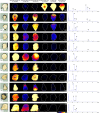Unveiling Dynamic Changes of Chemical Constituents in Raw and Processed Fuzi With Different Steaming Time Points Using Desorption Electrospray Ionization Mass Spectrometry Imaging Combined With Metabolomics
- PMID: 35359875
- PMCID: PMC8960191
- DOI: 10.3389/fphar.2022.842890
Unveiling Dynamic Changes of Chemical Constituents in Raw and Processed Fuzi With Different Steaming Time Points Using Desorption Electrospray Ionization Mass Spectrometry Imaging Combined With Metabolomics
Abstract
Fuzi is a famous toxic traditional herbal medicine, which has long been used for the treatment of various diseases in China and many other Asian countries because of its extraordinary pharmacological activities and high toxicity. Different processing methods to attenuate the toxicity of Fuzi are important for its safe clinical use. In this study, desorption electrospray ionization mass spectrometry imaging (DESI-MSI) with a metabolomics-combined multivariate statistical analysis approach was applied to investigate a series of Aconitum alkaloids and explore potential metabolic markers to understand the differences between raw and processed Fuzi with different steaming time points. Moreover, the selected metabolic markers were visualized by DESI-MSI, and six index alkaloids' contents were determined through HPLC. The results indicated visible differences among raw and processed Fuzi with different steaming times, and 4.0 h is the proper time for toxicity attenuation and efficacy reservation. A total of 42 metabolic markers were identified to discriminate raw Fuzi and those steamed for 4.0 and 8.0 h, which were clearly visualized in DESI-MSI. The transformation from diester-diterpenoid alkaloids to monoester-diterpenoid alkaloids and then to non-esterified diterpene alkaloids through hydrolysis is the major toxicity attenuation process during steaming. DESI-MSI combined with metabolomics provides an efficient method to visualize the changeable rules and screen the metabolic markers of Aconitum alkaloids during steaming. The wide application of this technique could help identify markers and reveal the possible chemical transition mechanism in the "Paozhi" processes of Fuzi. It also provides an efficient and easy way to quality control and ensures the safety of Fuzi and other toxic traditional Chinese medicine.
Keywords: DESI-MSI; Fuzi; diterpenoid alkaloids; processing; toxicity attenuation.
Copyright © 2022 Liu, Yang, Zhou, Wang, Kuang, Sun, Xu, Meng, Zhang and Tang.
Conflict of interest statement
Authors XY and CZ were employed by the company Waters Technology (Beijing) Co., Ltd. The remaining authors declare that the research was conducted in the absence of any commercial or financial relationships that could be construed as a potential conflict of interest.
Figures









Similar articles
-
Unveiling the processing mechanism of Hezi-decoction-processed Tiebangchui: a synthesis approach using UPLC-Q-TOF-MS-based metabolomics and DESI-MSI.Front Pharmacol. 2025 Apr 7;16:1534748. doi: 10.3389/fphar.2025.1534748. eCollection 2025. Front Pharmacol. 2025. PMID: 40260374 Free PMC article.
-
Spatial distribution and comparative analysis of Aconitum alkaloids in Fuzi using DESI-MSI and UHPLC-QTOF-MS.Analyst. 2023 Mar 27;148(7):1603-1610. doi: 10.1039/d2an02051c. Analyst. 2023. PMID: 36912125
-
Metabolomics study on Fuzi and its processed products using ultra-performance liquid-chromatography/electrospray-ionization synapt high-definition mass spectrometry coupled with pattern recognition analysis.Analyst. 2012 Jan 7;137(1):170-85. doi: 10.1039/c1an15833c. Epub 2011 Oct 26. Analyst. 2012. PMID: 22030742
-
Relationships between the Toxicities of Radix Aconiti Lateralis Preparata (Fuzi) and the Toxicokinetics of Its Main Diester-Diterpenoid Alkaloids.Toxins (Basel). 2018 Sep 26;10(10):391. doi: 10.3390/toxins10100391. Toxins (Basel). 2018. PMID: 30261585 Free PMC article. Review.
-
A review on phytochemistry and pharmacological activities of the processed lateral root of Aconitum carmichaelii Debeaux.J Ethnopharmacol. 2015 Feb 3;160:173-93. doi: 10.1016/j.jep.2014.11.043. Epub 2014 Dec 3. J Ethnopharmacol. 2015. PMID: 25479152 Review.
Cited by
-
Metabolomics for Clinical Biomarker Discovery and Therapeutic Target Identification.Molecules. 2024 May 8;29(10):2198. doi: 10.3390/molecules29102198. Molecules. 2024. PMID: 38792060 Free PMC article. Review.
-
Spatial metabolomics in mental disorders and traditional Chinese medicine: a review.Front Pharmacol. 2025 Jan 31;16:1449639. doi: 10.3389/fphar.2025.1449639. eCollection 2025. Front Pharmacol. 2025. PMID: 39959419 Free PMC article. Review.
-
Mass spectrometry imaging for unearthing and validating quality markers in traditional Chinese medicines.Chin Herb Med. 2024 May 28;17(1):31-40. doi: 10.1016/j.chmed.2024.04.005. eCollection 2025 Jan. Chin Herb Med. 2024. PMID: 39949808 Free PMC article. Review.
-
Spatial Metabolomics and Its Application in Plant Research.Int J Mol Sci. 2025 Mar 26;26(7):3043. doi: 10.3390/ijms26073043. Int J Mol Sci. 2025. PMID: 40243661 Free PMC article. Review.
-
Mass spectrometry imaging as a promising analytical technique for herbal medicines: an updated review.Front Pharmacol. 2024 Aug 1;15:1442870. doi: 10.3389/fphar.2024.1442870. eCollection 2024. Front Pharmacol. 2024. PMID: 39148546 Free PMC article. Review.
References
-
- Chen X., Tan P., He R., Liu Y.-g. (2013). Study on the Fragmentation Pathway of the Aconitine-type Alkaloids under Electrospray Ionization Tandem Mass Spectrometry Utilizing Quantum Chemistry. J. Pharm. Innov. 8, 83–89. 10.1007/s12247-013-9148-z - DOI
-
- Chinese Pharmacopoeia Commission (2020). The Pharmacopoeia of the People's Republic of China. 2020 edition. Beijing: China Medical Science Press, 200.
LinkOut - more resources
Full Text Sources

